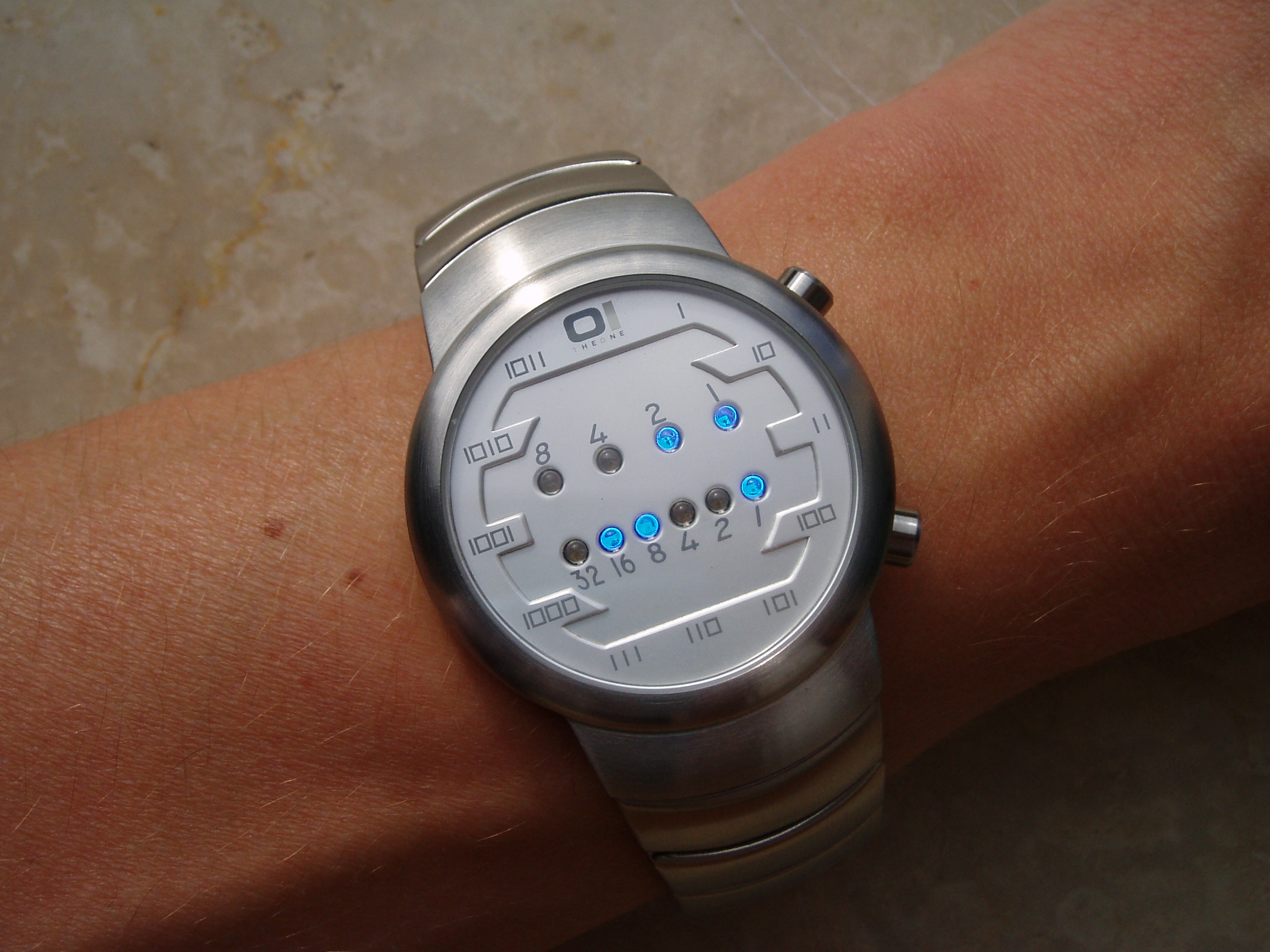题目链接
【题目】
A binary watch has 4 LEDs on the top which represent the hours (0-11), and the 6 LEDs on the bottom represent the minutes (0-59).
Each LED represents a zero or one, with the least significant bit on the right.

For example, the above binary watch reads “3:25”.
Given a non-negative integer n which represents the number of LEDs that are currently on, return all possible times the watch could represent.
Example:
Input: n = 1
Return: [“1:00”, “2:00”, “4:00”, “8:00”, “0:01”, “0:02”, “0:04”, “0:08”, “0:16”, “0:32”]
Note:
The order of output does not matter.
The hour must not contain a leading zero, for example “01:00” is not valid, it should be “1:00”.
The minute must be consist of two digits and may contain a leading zero, for example “10:2” is not valid, it should be “10:02”.
【分析】
有一个表是用二进制表示
4位表示小时
6位表示分钟
亮起来的地方表示1,反之则是0.
如果这个表一共亮了n个灯,问可能有多少可能的时间组合
很显然只是一种排列组合循环查找的问题:
下面分享不同语言的写法哈哈
1 C++
首先贴一个我大一写的代码,智障写法:
class Solution {
public:
int read_int(int pos1,int pos2 = 10,int pos3 = 10){
int temp = 0;
if(pos1 == 10){
return 0;
}
else if(pos2 == 10 && pos3 == 10){
temp = pow(2,pos1);
}
else if(pos2!=10 && pos3 == 10){
temp = pow(2,pos1)+pow(2,pos2);
}
else{
temp = pow(2,pos1)+pow(2,pos2)+pow(2,pos3);
}
return temp;
}
string read_string(int flag,bool rev,int pos1,int pos2=10, int pos3=10){
string s="";
int temp = 0;
temp = read_int(pos1,pos2,pos3);
if(rev == false){
temp = temp;
}
else{
if(flag == 0){
temp = 15-temp;
}
else{
temp = 63-temp;
}
}
if(temp>9){
s += char(temp/10+'0');
s += char(temp%10+'0');
}
else{
if(flag == 1)
s+=char('0');
s += char(temp + '0');
}
return s;
}
struct P{
int a0,a1,a2;
P(int b1,int b2,int b3){
a0 = b1;
a1 = b2;
a2 = b3;
}
};
vector<string> readBinaryWatch(int num) {
vector<string> v_s;
if(num==0) v_s.push_back("0:00");
else{
int i = num;
int j = 0;
vector<P> a[3],b[4];
a[0].push_back(P(10,10,10));
a[1].push_back(P(0,10,10));
a[1].push_back(P(1,10,10));
a[1].push_back(P(2,10,10));
a[2].push_back(P(0,1,10));
a[2].push_back(P(1,2,10));
a[2].push_back(P(2,3,10));
a[2].push_back(P(0,2,10));
a[2].push_back(P(1,3,10));
b[0].push_back(P(10,10,10));
b[1].push_back(P(0,10,10));
b[1].push_back(P(1,10,10));
b[1].push_back(P(2,10,10));
b[1].push_back(P(3,10,10));
b[1].push_back(P(4,10,10));
b[1].push_back(P(5,10,10));
b[2].push_back(P(0,1,10));
b[2].push_back(P(1,2,10));
b[2].push_back(P(2,3,10));
b[2].push_back(P(3,4,10));
b[2].push_back(P(4,5,10));
b[2].push_back(P(0,2,10));
b[2].push_back(P(1,3,10));
b[2].push_back(P(2,4,10));
b[2].push_back(P(3,5,10));
b[2].push_back(P(0,3,10));
b[2].push_back(P(1,4,10));
b[2].push_back(P(2,5,10));
b[2].push_back(P(0,4,10));
b[2].push_back(P(1,5,10));
b[2].push_back(P(0,5,10));
b[3].push_back(P(0,1,2));
b[3].push_back(P(1,2,3));
b[3].push_back(P(2,3,4));
b[3].push_back(P(3,4,5));
b[3].push_back(P(0,1,3));
b[3].push_back(P(0,1,4));
b[3].push_back(P(0,1,5));
b[3].push_back(P(1,2,4));
b[3].push_back(P(1,2,5));
b[3].push_back(P(0,2,3));
b[3].push_back(P(2,3,5));
b[3].push_back(P(0,3,4));
b[3].push_back(P(1,3,4));
b[3].push_back(P(0,4,5));
b[3].push_back(P(1,4,5));
b[3].push_back(P(2,4,5));
b[3].push_back(P(0,2,4));
b[3].push_back(P(0,2,5));
b[3].push_back(P(0,3,5));
b[3].push_back(P(1,3,5));
while(i>6){
i--;
j++;
}
while(j<=4&&j>=0&&i<=6&&i>=0){
int len1 = 0,len2 = 0;
string s1[20],s2[20];
if(j<=2){
for(int h = 0;h < a[j].size();h++){
s1[h] = read_string(0,false,a[j][h].a0,a[j][h].a1,a[j][h].a2);
len1 = h;
}
}
else if(j>2){
for(int h = 0;h<a[4-j].size();h++){
s1[h] = read_string(0,true,a[4-j][h].a0,a[4-j][h].a1,a[4-j][h].a2);
len1 = h;
}
}
if(i<=3){
for(int g = 0;g < b[i].size();g ++){
s2[g]=read_string(1,false,b[i][g].a0,b[i][g].a1,b[i][g].a2);
len2 = g;
}
}
else if(i>3){
for(int g = 0;g < b[6-i].size();g ++){
s2[g]=read_string(1,true,b[6-i][g].a0,b[6-i][g].a1,b[6-i][g].a2);
len2 = g;
}
}
len1++;
len2++;
for(int k1 = 0;k1<len1;k1++){
for(int k2 = 0;k2<len2;k2++){
string s = "";
if(s2[k2].size() == 2 && s2[k2][0] == '6'){
continue;
}
if(s1[k1].size() == 2 && s1[k1][1] >= '2'){
continue;
}
s = s1[k1] + ":" + s2[k2];
v_s.push_back(s);
}
}
j++;
i--;
}
}
return v_s;
}
};现在看着就很好笑,不过自然就是这么改变进步的吧
这道题可以用深度搜索的方法写,网上也是其他做法
分享一个简短的利用内置类与函数的解法,bitset是一个内置类,可以将其他进制的数转换为二进制,和一个count函数,来计算1的个数
class Solution {
public:
vector<string> readBinaryWatch(int num)
{
vector<string> ans;
for(int i = 0; i < 12; i ++ )
{
for (int j = 0 ; j < 60 ; j ++ )
{
if(bitset<10>((i<<6)+j).count() == num)
{
ans.push_back(to_string(i) + (j<10?":0":":") + to_string(j));
}
}
}
return ans;
}
};很强!
2 python:
当然想到排列组合,自然想到python的itertools里面的两个函数,permutations和combinations
前者有区别先后,后者没有,这道题中由于我们并不在意(1,2)和(2,1)的区别,所以自然用combinations()
class Solution(object):
def readBinaryWatch(self, num):
"""
:type num: int
:rtype: List[str]
"""
from itertools import combinations
def get_int_from_LED(n,k):
value = [2**i for i in range(k)]
comb = combinations(value,n)
ans = []
for item in comb:
ans += [sum(item)]
return ans
ans = []
for i in range(min(5,num+1)):
j = num - i
value4 = get_int_from_LED(i,4)
value6 = get_int_from_LED(j,6)
for v4 in value4:
for v6 in value6:
if v4 < 12 and v6 < 60:
temp = str(v6) if v6 > 9 else "0" + str(v6)
ans.append(str(v4) + ":" + temp)
return ans
同样的python中也有二进制的内置函数,可以一行搞定:
def readBinaryWatch(self, num):
return ['%d:%02d'.format(h,m) for m in range(60) for h in range(12) if (bin(h) + bin(m)).count('1') == num]3 java:
下面的做法将所有情况列举出来,循环求解结果,但是很快
public class Solution {
String[][] hour = {{"0"},
{"1", "2", "4", "8"},
{"3", "5", "6", "9", "10"},
{"7", "11"}};
String[][] minute = {{"00"}, //1
{"01", "02", "04", "08", "16", "32"}, //6
{"03", "05", "06", "09", "10", "12", "17", "18", "20", "24", "33", "34", "36", "40", "48"}, //15
{"07", "11", "13", "14", "19", "21", "22", "25", "26", "28", "35", "37", "38", "41", "42", "44", "49", "50", "52", "56"}, //20
{"15", "23", "27", "29", "30", "39", "43", "45", "46", "51", "53", "54", "57", "58"}, //14
{"31", "47", "55", "59"}}; //4
public List<String> readBinaryWatch(int num) {
List<String> ret = new ArrayList();
for (int i = 0; i <= 3 && i <= num; i++) {
if (num - i <= 5) {
for (String str1 : hour[i]) {
for (String str2 : minute[num - i]) {
ret.add(str1 + ":" + str2);
}
}
}
}
return ret;
}
}是的,java也有二进制:
public List<String> readBinaryWatch(int num) {
List<String> times = new ArrayList<>();
for (int h=0; h<12; h++)
for (int m=0; m<60; m++)
if (Integer.bitCount(h * 64 + m) == num)
times.add(String.format("%d:%02d", h, m));
return times;
}4 javascript:
最后,分享一种js解法:
var readBinaryWatch = function(num) {
var hour,
minutes,
numBits,
result = [],
hourFormat = "";
for(hour = 0; hour <= 11; hour++){
for(minutes = 0; minutes <= 59; minutes++){
numBits = hour.toString(2).split(1).length - 1;
numBits += minutes.toString(2).split(1).length - 1;
if(numBits === num){
hourFormat = hour.toString() + ":" + (minutes < 10? '0' + minutes.toString() : minutes.toString());
result.push(hourFormat);
}
}
}
return result;
};







 这篇博客介绍了LeetCode 401题——二进制手表,解释如何根据点亮的LED数推算可能显示的时间。内容涵盖了C++、Python、Java和JavaScript四种语言的解决方案,通过深度搜索、内置类和函数以及循环求解等方法实现。
这篇博客介绍了LeetCode 401题——二进制手表,解释如何根据点亮的LED数推算可能显示的时间。内容涵盖了C++、Python、Java和JavaScript四种语言的解决方案,通过深度搜索、内置类和函数以及循环求解等方法实现。














 999
999

 被折叠的 条评论
为什么被折叠?
被折叠的 条评论
为什么被折叠?








